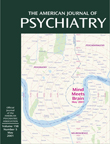Drs. De Bellis and Keshavan Reply
To the Editor: We appreciate the comments by Mr. Tae and Dr. Hong. The amygdala and hippocampus are often hard to differentiate from each other, even at a histologic level. On the basis of earlier work in studies of child and adolescent psychiatry (1–4), we utilized a landmark method to differentiate these structures. In this method, the slice showing the most anterior mammillary bodies is used as the amygdala-hippocampus boundary. The disadvantage of this landmark method is that measures of the anterior hippocampus may include some of the posterior amygdala on a small number of slices. As described in our article and outlined in Figure 2, our measurement of the anterior hippocampus can potentially include a small part of the posterior amygdala. Therefore, we explored whether this difference is related to the few slices that contain both the amygdala and hippocampus. Secondary analysis of our results revealed that the smaller hippocampal volumes seen in subjects with adolescent-onset alcohol use disorders was not due to our decision to use this landmark method (total hippocampal volume adjusted for intracranial volume: F=6.27, df=1, 33,p<0.02).
As stated by Mr. Tae and Dr. Hong, recent studies in adult psychiatry show that visualizing the hippocampus perpendicular to its long axis, a modification of our landmark method, has the advantage of separating the posterior amygdala from the anterior hippocampus and the disadvantage of including the adjacent entorhinal cortex in the measurement of the anterior amygdala (5–7). We agree that MRI measurement methodology is an important issue to keep in mind when comparing data across different studies. Since standardizing hippocampal measures across development is an important issue, we have began utilizing both methods in our image analysis.
1. Giedd JN, Vaituzis AC, Hamburger SD, Lange N, Rajapakse JC, Kaysen D, Vauss YC, Rapoport JL: Quantitative MRI of the temporal lobe, amygdala, and hippocampus in normal human development: ages 4–18. J Comp Neurol 1996; 366:223–230Crossref, Medline, Google Scholar
2. Castellanos FX, Giedd JN, Marsh WL, Hamburger SD, Vaituzis AC, Dickstein DP, Sarfatti SE, Vauss YC, Snell JW, Lange N, Kaysen D, Krain AL, Ritchie GF, Rajapakse JC, Rapoport JL: Quantitative brain magnetic resonance imaging in attention-deficit hyperactivity disorder. Arch Gen Psychiatry 1996; 53:607–616Crossref, Medline, Google Scholar
3. Jacobsen LK, Giedd JN, Castellanos FX, Vaituzis AC, Hamburger SD, Kumra S, Lenane MC, Rapoport JL: Progressive reduction of temporal lobe structures in childhood-onset schizophrenia. Am J Psychiatry 1998; 155:678–685Link, Google Scholar
4. De Bellis MD, Keshavan M, Clark DB, Casey BJ, Giedd J, Boring AM, Frustaci K, Ryan ND: A.E. Bennett Research Award: developmental traumatology, part II: brain development. Biol Psychiatry 1999; 45:1271–1284Google Scholar
5. Watson C, Andermann F, Gloor P, Jones-Gotman M, Peters T, Evans A, Olivier A, Melanson D, Leroux G: Anatomic basis of amygdaloid and hippocampal volume measurement by magnetic resonance imaging. Neurology 1992; 42:1743–1750Google Scholar
6. Altshuler LL, Bartzokis G, Greider T, Curran J, Mintz J: Amygdala enlargement in bipolar disorder and hippocampal reduction in schizophrenia: an MRI study demonstrating neuroanatomic specificity. Arch Gen Psychiatry 1998; 55:663–666Medline, Google Scholar
7. Bartzokis G, Altshuler LL, Greider T, Curran J, Keen B, Dixon WJ: Reliability of medial temporal lobe volume measurements using reformatted 3D images. Psychiatry Res 1998; 82:11–24Crossref, Medline, Google Scholar



